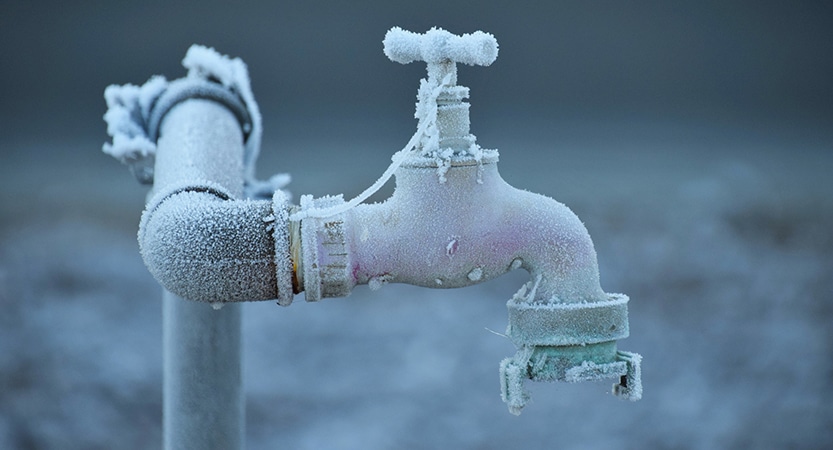Avoiding Pipes from Freezing: Top Tips
Avoiding Pipes from Freezing: Top Tips
Blog Article
We have uncovered this article on Winter Plumbing Precautions: Preventing Frozen Pipes listed below on the web and accepted it made perfect sense to talk about it with you on this site.
:strip_icc()/snow-outdoor-faucet-pipes-4af65d1e5e904fb1aa7bf74071fe5d89.jpg)
Winter can damage your plumbing, particularly by freezing pipelines. Below's exactly how to stop it from taking place and what to do if it does.
Introduction
As temperatures decline, the threat of frozen pipes boosts, potentially causing costly fixings and water damages. Understanding just how to avoid frozen pipes is crucial for house owners in cold climates.
Recognizing Frozen Pipes
What causes pipelines to freeze?
Pipes freeze when revealed to temperature levels below 32 ° F (0 ° C) for extended durations. As water inside the pipes freezes, it broadens, putting pressure on the pipeline walls and potentially creating them to break.
Dangers and problems
Frozen pipelines can cause water system disturbances, property damage, and costly repair work. Ruptured pipelines can flood homes and cause substantial structural damage.
Signs of Frozen Piping
Recognizing icy pipelines early can prevent them from rupturing.
Just how to determine icy pipelines
Seek reduced water flow from faucets, uncommon smells or sounds from pipes, and visible frost on exposed pipelines.
Avoidance Tips
Protecting prone pipes
Cover pipelines in insulation sleeves or make use of heat tape to safeguard them from freezing temperature levels. Focus on pipelines in unheated or external areas of the home.
Heating methods
Keep indoor areas effectively warmed, especially areas with plumbing. Open cupboard doors to permit warm air to distribute around pipes under sinks.
Securing Exterior Plumbing
Yard hoses and outdoor faucets
Detach and drain pipes yard hose pipes before wintertime. Mount frost-proof faucets or cover exterior faucets with protected caps.
What to Do If Your Pipelines Freeze
Immediate activities to take
If you suspect frozen pipes, keep faucets available to eliminate pressure as the ice thaws. Use a hairdryer or towels taken in hot water to thaw pipes slowly.
Long-Term Solutions
Structural adjustments
Take into consideration rerouting pipes far from exterior walls or unheated areas. Include added insulation to attics, basements, and crawl spaces.
Updating insulation
Buy top notch insulation for pipelines, attic rooms, and wall surfaces. Proper insulation aids preserve consistent temperature levels and minimizes the danger of icy pipes.
Verdict
Protecting against icy pipes requires aggressive measures and quick feedbacks. By recognizing the causes, signs, and safety nets, house owners can shield their plumbing throughout winter.
5 Ways to Prevent Frozen Pipes
Drain Outdoor Faucets and Disconnect Hoses
First, close the shut-off valve that controls the flow of water in the pipe to your outdoor faucet. Then, head outside to disconnect and drain your hose and open the outdoor faucet to allow the water to completely drain out of the line. Turn off the faucet when done. Finally, head back to the shut-off valve and drain the remaining water inside the pipe into a bucket or container. Additionally, if you have a home irrigation system, you should consider hiring an expert to clear the system of water each year.
Insulate Pipes
One of the best and most cost-effective methods for preventing frozen water pipes is to wrap your pipes with insulation. This is especially important for areas in your home that aren’t exposed to heat, such as an attic. We suggest using foam sleeves, which can typically be found at your local hardware store.
Keep Heat Running at 65
Your pipes are located inside your walls, and the temperature there is much colder than the rest of the house. To prevent your pipes from freezing, The Insurance Information Institute suggests that you keep your home heated to at least 65 degrees, even when traveling. You may want to invest in smart devices that can keep an eye on the temperature in your home while you’re away.
Leave Water Dripping
Moving water — even a small trickle — can prevent ice from forming inside your pipes. When freezing temps are imminent, start a drip of water from all faucets that serve exposed pipes. Leaving a few faucets running will also help relieve pressure inside the pipes and help prevent a rupture if the water inside freezes.
Open Cupboard Doors
Warm your kitchen and bathroom pipes by opening cupboards and vanities. You should also leave your interior doors ajar to help warm air circulate evenly throughout your home.

I was made aware of that report about How to prepare your home plumbing for winter weather through someone on another web page. Do you know anybody else who is very much interested in the topic? Please feel free to share it. I love your readership.
Schedule Service Pickup Report this page